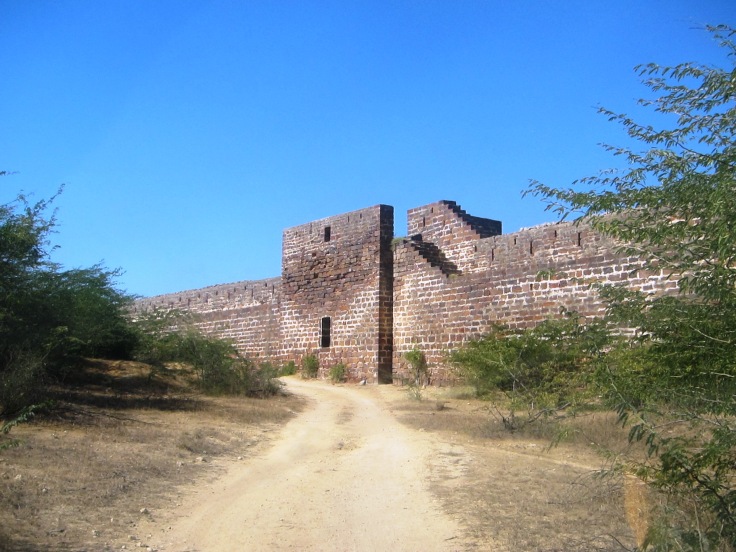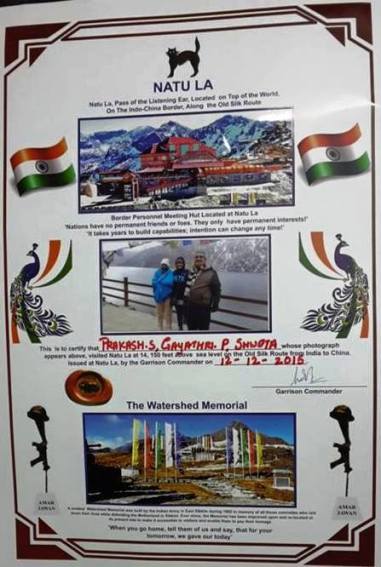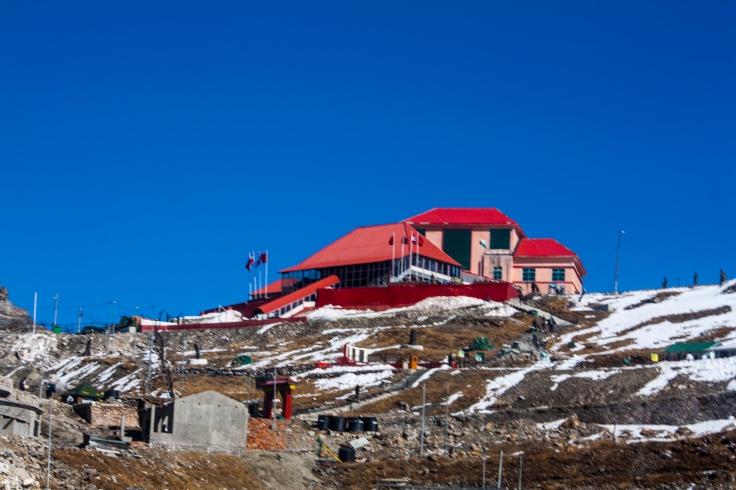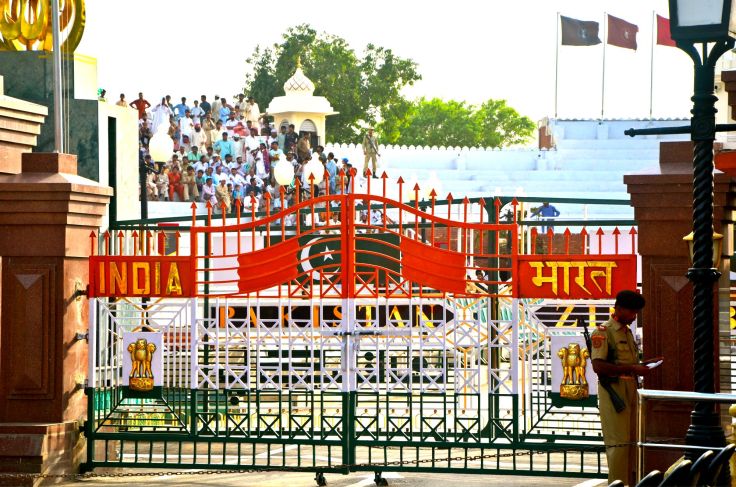For a really long time when I was a kid, I wanted to be a truck driver. No this wasn’t when I was 5 it was when I was almost 14!! I don’t remember where the idea stemmed from exactly, but the dialogue “mere pitaji truck driver the jo Gujarat se Rajasthan hokar Dilli Jate the” is still fresh in my mind!!

Source: Internet
 I always thought it was a great way to see the country, driving on free highways, eating at dhabas! But the best part, the one that attracted me the most, was that these people got to travel so much, such faraway places, such remote locations, sometimes even crossing across international borders. And therein lay my actual interest!! It was not so much the trucks, it was the places these people crossed, the people they met.
I always thought it was a great way to see the country, driving on free highways, eating at dhabas! But the best part, the one that attracted me the most, was that these people got to travel so much, such faraway places, such remote locations, sometimes even crossing across international borders. And therein lay my actual interest!! It was not so much the trucks, it was the places these people crossed, the people they met.
Source: Internet
So once it was established I could not become a truck driver, I set a much smaller and simpler goal. I wanted to see India’s international borders, at-least the ones where civilians were permitted. And obviously Wagah was the only place I knew that was possible.
But a visit to Wagah did not happen anytime soon for me. It was almost a decade, before I finally did get to see the ceremony there. But now I can proudly say I have had two and a half encounters with International borders. Half because that one didn’t give me the same thrills.
India Bridge, Kutch
This was part of a long trip to Kutch. By now we had seen so many places around, and had heard so many times “idhar se Pakistan sirf X km hai”, that we were now losing interest.

Source: Internet
However one place that did catch my attention was the fort at Lakhpat. The ghost town does not have much for you to see, but the stories of its past glory and prosperity are quite interesting. Apparently, the town was an important riverine port of the Indus/Sindhu and thus served as a trade hub between Gujarat and Sindh. It was also fertile and grew rice. But then a massive earthquake struck, and the Indus changed its course. It took away with it the fertility and the trade from Lakhpat. And the once prosperous town was reduced to a deserted fortress with very few inhabitants. Beyond the walls of this fort, is a salt marsh land, which has the Indo-Pak border, and hence the walls are guarded by BSF at all times.
India Bridge is the last point in the Rann of Kutch where civilians are allowed. To cross the bridge and beyond, you require special permission from the BSF. The place itself is not much, a high view point and a memorial/museum for BSF. That’s all there is to the place, and unless you talk to the men on duty or the people who live in the vicinity, you have no idea either of your proximity to the international border, or of the hardships involved in living in the area. And therefore this one makes for the ‘half’ encounter.
Nathu La, Sikkim
My parents’ birthday gift to me in 2015 was my favorite one yet, it was spending the day at the Indo-China border at Nathu La!! So we went on a 5 day trip to Sikkim. The journey started from Bagdogra airport, with winding roads and construction every few miles. By the time we reached our resort in Gangtok, we had seen quite a few sites with the sign, BRO. Once at the resort, we shared our ID cards and other details with the reception. They would arrange for our permits to visit Nathu La. The next day we started after an early breakfast, and the chef packed sandwiches for us, saying we would need these as it was difficult to find food closer to the pass. We met our driver, a young lad with a battered old Tata Sumo. The tyres were well weathered and worn out and I was not encouraged. We started our journey and as is the case with most drivers in the hills, he started relating various incidents of road accidents that had taken place on these very roads.
 Source: Internet
Source: Internet
The drive to Nathu La was scary to say the least, and December is definitely not the best time to be there. We again encountered a lot of under-construction sites, courtesy BRO. The Border Roads Organization does a great job of keeping these hilly roads in shape and it doesn’t exactly take a civil engineer to appreciate the amount of difficulties these people have to undertake to ensure the borders are always accessible. What’s also interesting is the fun signs they have on the roads:
- Go slowly on my curves
- After whiskey driving risk
- Jinhe jaldi thi wo chale gaye
And the likes!!
We finally got to the point where we had to let go of our vehicles and walk. And as if on cue, it started snowing!! As we made our way through the slope and steps leading to the check-post, we realized that this was going to be a difficult 500m to walk. We stopped at the tiny makeshift café that serves momos and coffee. But more importantly, it serves as a stopover to help acclimatize to the place.
 When we finally reached the check-post we were met with blowing winds, biting cold and the Chinese guards from across the border!! The long drive, the cold and the snow were all worth the thrill of standing a few feet away from the Chinese border. I was a bit too excited and went ahead and asked the Chinese soldier for a selfie which he obviously refused. But they did talk to us. And so did the Indian soldiers, they told us how they spent months in the same place, with just each other for company. Of how on good days, they chatted up their counterparts from across and how the cold was “just normal”!! They even told me I could get a certificate stating I had been at the border, and told us we should visit the Baba Harbhajan Singh ka mandir on our way back.
When we finally reached the check-post we were met with blowing winds, biting cold and the Chinese guards from across the border!! The long drive, the cold and the snow were all worth the thrill of standing a few feet away from the Chinese border. I was a bit too excited and went ahead and asked the Chinese soldier for a selfie which he obviously refused. But they did talk to us. And so did the Indian soldiers, they told us how they spent months in the same place, with just each other for company. Of how on good days, they chatted up their counterparts from across and how the cold was “just normal”!! They even told me I could get a certificate stating I had been at the border, and told us we should visit the Baba Harbhajan Singh ka mandir on our way back.
 Source: Internet
Source: Internet
Harbhajan Singh was a soldier of the Indian Army who went missing and then died in 1968. It is widely believed by soldiers in this region that his spirit protects them from all the danger of the neighbors and of mother nature. They have therefore built a shrine honoring him. Every year, in September, a member from Baba’s regiment leaves Sikkim with his personal belongings and accompanies Baba home to his village in Punjab. A reservation is made in Baba’s name every year for the train journey.
If you interact with soldiers, you’ll hear many such stories. These are true stories no doubt, but they are also legend that have been kept alive through the years, as these serve as both motivation and security to these soldiers as they guard our country in extreme conditions. It is for them to know that there is a spirit guiding them and looking out for them.
Wagah-Attari, Punjab
And finally after having read/thought about it for far too long, I got to visit the Wagah Border!! It was part of our graduation trip; I know it’s not the first choice for grad-trip! But in our defense we did do the clichéd Goa as well!
So we were reaching Amritsar by train at 12pm and had plans of cleaning up and leaving early to Wagah to ensure good spots. But as luck and the Indian Railways would have it, the train was late by almost 2 hours, and by the time we had navigated the narrow by-lanes of Amritsar to find our lodge and dump our luggage, we were almost late for the ceremony.
Pleading the share-auto to go as-fast as it could, we reached just as the band started playing. And then there were the zillion security points to get through! I thought this was it and that I would neither get a spot nor be able to see the ceremony. But finally we were done and as we raced through the crowds, we managed to get enough space to just about stand! The band was playing and the soldiers were preparing. There were chants of India all around, with the flags flying high and face paint to compliment.
 The ceremony started off with a man (in white in the picture above) who encouraged people to cheer louder, and who set the tone for the evening. He ensured every patriotic muscle in your body was wide awake and playing its part! Then the soldiers all lined up and we heard the famous and extremely loooooong drawn commands. We also heard similar sounds from across the gate. The soldiers then marched ahead towards the gate, putting up quite a show for the spectators, and then the lowering of the flags began. While the flags were being lowered a cheer-leading match had ensued between the two sides, and on that particular day, India just had larger numbers and a mighty enthusiastic audience. By the time the flags had been lowered and returned respectfully to the BSF office, we had shouted ourselves hoarse and elbowed a few people around to get better views.
The ceremony started off with a man (in white in the picture above) who encouraged people to cheer louder, and who set the tone for the evening. He ensured every patriotic muscle in your body was wide awake and playing its part! Then the soldiers all lined up and we heard the famous and extremely loooooong drawn commands. We also heard similar sounds from across the gate. The soldiers then marched ahead towards the gate, putting up quite a show for the spectators, and then the lowering of the flags began. While the flags were being lowered a cheer-leading match had ensued between the two sides, and on that particular day, India just had larger numbers and a mighty enthusiastic audience. By the time the flags had been lowered and returned respectfully to the BSF office, we had shouted ourselves hoarse and elbowed a few people around to get better views.
 Source: Internet
Source: Internet
The atmosphere here is very different from the other 2 places. It is charged with patriotism, with a feeling of being Indian, and of trying to prove that we are better, even if it as at shouting!! The soldiers here are far friendlier, willing to talk and to click pictures with us. They told us of how they have been part of the ceremony for years, what it is like to talk to the soldiers on the other side, and how even on days that the ceremony doesn’t happen, they sometimes greet each other.

What caught my attention was that the soldiers on both sides were Sikhs. Probably they were distant cousins; probably their grandfathers had been friends. And there lies the aura of this border. It is very much alive. These are people who used to be neighbors, and have seen a line drawn out between their homes all in the past one generation. It is not really an old story. They did have farms adjoining each other in what are now India and Pakistan. They used to take the Grand Trunk Road to go from Lahore to Amritsar to pray at Harmandir Sahib or to meet an aunt that was married to Lahore. And all this in the not so distant past. In-fact there are still groups of people from Punjab, India that visit Nankana Sahib (the Birthplace of Guru Nanak) and other sacred places in Punjab, Pakistan. Only now it takes them months to plan and lots and lots of paperwork. The people of Wagah, Attari and all the nearby villages have spent most of their lives knowing they are too close to danger. Maybe not the danger of guns and bullets, but of being mistaken as spies, of being so close and yet so far from relatives and of being the first place that Delhi targets every time there are talks between the two countries.
In recent times the ceremony has become a gauge of Indo-Pak relations, for every time there are issues, big or small, it is this ceremony that is first called off. That just is a reflection of everything the ceremony stands for, of peaceful relations between the two countries, of possible friendships, and of a people that have been divided neither out of choice nor want.

Very beautifully narrated , makes very interesting reading,,, kudo’s,
LikeLike